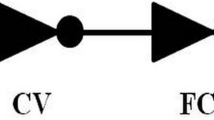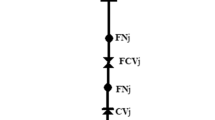Abstract
In water distribution systems (WDSs), the available flow at a demand node is dependent on the pressure at that node. When a network is lacking in pressure, not all consumer demands will be met in full. In this context, the assumption that all demands are fully satisfied regardless of the pressure in the system becomes unreasonable and represents the main limitation of the conventional demand driven analysis (DDA) approach to WDS modelling. A realistic depiction of the network performance can only be attained by considering demands to be pressure dependent. This paper presents an extension of the renowned DDA based hydraulic simulator EPANET 2 to incorporate pressure-dependent demands. This extension is termed “EPANET-PDX” (pressure-dependent extension) herein. The utilization of a continuous nodal pressure-flow function coupled with a line search and backtracking procedure greatly enhance the algorithm’s convergence rate and robustness. Simulations of real life networks consisting of multiple sources, pipes, valves and pumps were successfully executed and results are presented herein. Excellent modelling performance was achieved for analysing both normal and pressure deficient conditions of the WDSs. Detailed computational efficiency results of EPANET-PDX with reference to EPANET 2 are included as well.






















Similar content being viewed by others
References
Ackley JRL, Tanyimboh TT, Tahar B, Templeman AB (2001) Head-driven analysis of water distribution systems. In: Ulanicki B, Coulbeck B, Rance J (eds) Water Software Systems: Theory and Applications, Vol. 1. Research Studies Press Ltd, England, ISBN 0863802745, Chapter 3:183–192
Alperovits E, Shamir U (1977) Design of optimal water distribution systems. Water Resour Res 13(6):885–900
Ang WH, Jowitt PW (2006) Solution for water distribution systems under pressure-deficient conditions. J Water Resour Plann Manag, ASCE 132(3):175–182
Bhave PR (1991) Analysis of flow in water distribution networks. Technomic Publishing, Lancaster
Christodoulou SE (2010) Water network assessment and reliability analysis by use of survival analysis. Water Resour Manag 25(4):1229–1238
Cisty M (2010) Hybrid genetic algorithm and linear programming method for least-cost design of water distribution systems. Water Resour Manag 24(1):1–24
Cullinane MJ, Lansey KE, Mays LW (1992) Optimisation-availability-based design of water distribution networks. J Hydraul Eng 118(3):420–441
Fujiwara O, Ganesharajah T (1993) Reliability assessment of water supply systems with storage and distribution networks. Water Resour Res 29(8):2917–2924
Germanopoulos G (1985) A technical note on the inclusion of pressure dependent demand and leakage terms in water supply network models. Civ Eng Syst 2:171–179
Giustolisi O, Kapelan Z, Savic DA (2008a) Extended period simulation analysis considering valve shutdowns. J Water Resour Plann Manag 134(6):527–537
Giustolisi O, Savic DA, Kapelan Z (2008b) Pressure-driven demand and leakage simulation for water distribution networks. J Hydraul Eng 134(5):626–635
Gupta R, Bhave PR (1996) Comparison of methods for predicting deficient network performance. J Water Resour Plann Manag 122(3):214–217
Haghighi A, Samani HMV, Samani ZMV (2011) GA-ILP method for optimization of water distribution networks. Water Resour Manag 25(7):1791–1808
Jeppson RW, Davis A (1976) Pressure reducing valves in pipe network analyses. J Hydraul Div 102(HY7):987–1001
Kalungi P, Tanyimboh TT (2003) Redundancy model for water distribution systems. Reliab Eng Syst Saf 82(3):275–286
Liberatore S, Sechi GM (2009) Location and calibration of valves in water distribution networks using a scatter-search meta-heuristic approach. Water Resour Manag 23:1479–1495
Martínez-Rodríguez JB, Montalvo I, Izquierdo J, Pérez-García R (2011) Reliability and Tolerance Comparison in Water Supply Networks. Water Resour Manag 25(5):1437–1448
OFWAT (2004) Levels of Service for the Water Industry in England and Wales. 2002–2003 Report. Ofwat Centre, 7 Hill Street, Birmingham B5 4UA, UK
Park S, Choi CL, Kim JH, Bae CH (2010) Evaluating the economic residual life of water pipes using the proportional hazards model. Water Resour Manag 24(12):3195–3217
Press WH, Teukolsky SA, Vetterling WT, Flannery BP (1992) Numerical recipes in FORTRAN: the art of scientific computing. Cambridge University Press, New York
Reddy LS, Elango K (1989) Analysis of water distribution networks with head dependent outlets. Civ Eng Syst 6(3):102–110
Rossman LA (2002) EPANET 2 User’s Manual, Water Supply and Water Resources Division, National Risk Management Research Laboratory, Cincinnati, OH45268
Rossman LA (2007) Discussion of ‘Solution for water distribution systems under pressure-deficient conditions’. J Water Resour Plann Manag 133(6):566–567
Salgado R, Rojo J, Zepeda S (1993) Extended gradient method for fully non-linear head and flow analysis in pipe networks. Integrated Computer Applications in Water Supply—Methods and Procedures for Systems Simulation and Control 1:49–60
Shan N (2004) Head dependent modelling of water distribution network. MSc Dissertation, University of Liverpool, UK
Siew C, Tanyimboh TT (2010a) Pressure-dependent EPANET extension: pressure-dependent demands. Proceedings of the 12th Annual Water Distribution Systems Analysis Conference, WDSA 2010, September 12–15, Tucson, Arizona
Siew C, Tanyimboh TT (2010b) Penalty-Free Multi-Objective Evolutionary Optimization of Water Distribution Systems. Proceedings of the 12th Annual Water Distribution Systems Analysis Conference, WDSA 2010, September 12–15, Tucson, Arizona
Siew C, Tanyimboh TT (2011a) The computational efficiency of EPANET-PDX. Proceedings of the 13th Annual Water Distribution Systems Analysis Conference, WDSA 2011, May 22–26, Palm Springs, California
Siew C, Tanyimboh TT (2011b) Design of the “Anytown” network using the penalty-free multi-objective evolutionary optimization approach. Proceedings of the 13th Annual Water Distribution Systems Analysis Conference, WDSA 2011, May 22–26, Palm Springs, California
Siew C, Tanyimboh TT (2011c) Penalty-free evolutionary algorithm optimization for the long term rehabilitation and upgrading of water distribution systems. Proceedings of the 13th Annual Water Distribution Systems Analysis Conference, WDSA 2011, May 22–26, Palm Springs, California
Tabesh M, Tanyimboh TT, Burrows R (2002) Head driven simulation of water supply networks. Int J Eng, Transactions A: Basics 15(1):11–22
Tabesh M, Yekta A, Burrows R (2009) An integrated model to evaluate losses in water distribution systems. Water Resour Manag 23(3):477–492
Tanyimboh TT (2008) Robust algorithm for head-dependent analysis of water distribution systems. In: Van Zyl JE, Ilemobade AA, Jacobs HE (eds) Proceedings of the 10th Annual Water Distribution Systems Analysis Conference, August 17–20, Kruger National Park, South Africa
Tanyimboh TT, Templeman AB (2004) A new nodal outflow function for water distribution networks. In: Topping BHV, Mota Soares CA (eds) Proceedings of the 4th International Conf. on Eng. Computational Technology. Civil-Comp Press, Stirling, UK, ISBN 0-948749-98-9, Paper 64, pp. 12, CD-ROM
Tanyimboh TT, Templeman AB (2010) Seamless pressure-deficient water distribution system model. J Water Manag ICE 163(8):389–396
Tanyimboh TT, Tahar B, Templeman AB (2003) Pressure-driven modelling of water distribution systems. Water Sci Tech Water Supply 3(1–2):255–262
Todini E, Pilati S (1988) A gradient algorithm for the analysis of pipe networks. In: Coulbeck B, Orr C-H (eds) Computer applications in water supply, vol 1. Research Studies Press, England
Udo A, Ozawa T (2001) Steady-state flow analysis of pipe networks considering reduction of flow in the case of low water pressures. In: Ulanicki B, Coulbeck B, Rance J (eds) Water software systems: theory and applications, vol 1. Research Studies Press, Taunton, pp 73–182
Wagner JM, Shamir U, Marks DH (1988) Water distribution reliability: simulation methods. J Water Resour Plann Manag 114(3):276–294
Walski TM, Brill ED, Gessler J, Goulter IC, Jeppson RM, Lansey K, Lee HL, Liebman JC, Mays L, Morgan DR, Ormsbee L (1987) Battle of the network models: epilogue. J Water Resour Plann Manag 113(2):191–203
Wu YW, Wang RH, Walski TM, Yang SY, Bowdler D, Baggett CC (2009) Extended global-gradient algorithm for pressure-dependent water distribution analysis. J Water Resour Plann Manag 135(1):13–22
Xu C (2001) Re: modelling demands. www.bossintl.com/forums/showthr…/threadid/5176.htm, June 2001, accessed 2002 by Tanyimboh and Templeman (2004)
Acknowledgements
This research was funded in part by the UK Engineering and Physical Sciences Research Council under Grant Number EP/G055564/1. The authors are grateful to the British Government (Overseas Research Students Award Scheme) and the University of Strathclyde for funding for the first author’s PhD programme.
Author information
Authors and Affiliations
Corresponding author
Rights and permissions
About this article
Cite this article
Siew, C., Tanyimboh, T.T. Pressure-Dependent EPANET Extension. Water Resour Manage 26, 1477–1498 (2012). https://doi.org/10.1007/s11269-011-9968-x
Received:
Accepted:
Published:
Issue Date:
DOI: https://doi.org/10.1007/s11269-011-9968-x




